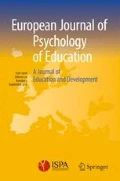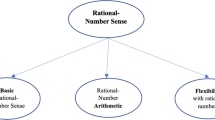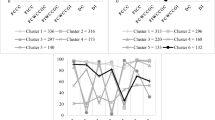Abstract
Rational numbers can be represented in multiple formats (e.g., fractions, decimals, and percentages), and a rational number notation can be used to express different concepts in different contexts. The present study investigated the distribution of the multiple concepts expressed by these different rational number notations in real-world contexts as well as the semantic alignment between entity type (discrete vs. continuous) and rational number format (decimal vs. fraction) in the Chinese context. Textbook analysis and two paper-and-pencil experiments yielded the following four major findings: (1) Decimals were more likely used to represent numerical magnitudes, while fractions were more likely used to represent relations between two numerical magnitudes. (2) Decimals were more often used to represent continuous entities while fractions were preferred to represent discrete entities. (3) The strength of the association between different formats of rational numbers and their preferred conceptual meanings seemed more pronounced than the semantic alignment between number type and entity type. (4) Percentages were used in a way more similar to fractions than decimals in terms of the concepts they express. These findings indicate that different formats of rational numbers differ dramatically in their use in real-world contexts both in terms of the conceptual meanings they express and the entities they model. Educational implications of this study are discussed.


Similar content being viewed by others
Data availability
The data that support the findings of this study are available from the corresponding author upon reasonable request.
References
Bassok, M., Chase, V. M., & Martin, S. A. (1998). Adding apples and oranges: alignment of semantic and formal knowledge. Cognitive Psychology, 35(2), 99–134. https://doi.org/10.1006/cogp.1998.0675.
Bassok, M., Pedigo, S. F., & Oskarsson, A. T. (2008). Priming addition facts with semantic relations. Journal of Experimental Psychology: Learning, Memory, and Cognition, 34(2), 343–352. https://doi.org/10.1037/0278-7393.34.2.343.
Behr, M. J., Wachsmuth, I., Post, T. R., & Lesh, R. (1984). Order and equivalence of rational numbers: a clinical teaching experiment. Journal for Research in Mathematics Education, 15(5), 323–341. https://doi.org/10.2307/748423.
Beijing Normal University Publishing Group. (2014). Mathematics textbook for elementary school. Beijing.
Bonato, M., Fabbri, S., Umiltà, C., & Zorzi, M. (2007). The mental representation of numerical fractions: real or integer? Journal of Experimental Psychology: Human Perception and Performance, 33(6), 1410–1419. https://doi.org/10.1037/0096-1523.33.6.1410.
Carey, S. (2000). Science education as conceptual change. Journal of Applied Developmental Psychology, 21(1), 13–19. https://doi.org/10.1016/S0193-3973(99)00046-5.
Chen, X., He, B., & Zhang, J. (2012). The integration of arithmetic knowledge and semantic knowledge in addition facts. Acta Psychologica Sinica, 44(6), 720–734. https://doi.org/10.3724/SP.J.1041.2012.00720.
DeWolf, M., Grounds, M. A., Bassok, M., & Holyoak, K. J. (2014). Magnitude comparison with different types of rational numbers. Journal of Experimental Psychology: Human Perception and Performance, 40(1), 71–82. https://doi.org/10.1037/a0032916.
DeWolf, M., Bassok, M., & Holyoak, K. J. (2015). Conceptual structure and the procedural affordances of rational numbers: relational reasoning with fractions and decimals. Journal of Experimental Psychology: General, 144(1), 127–150. https://doi.org/10.1037/xge0000034.
Gabriel, F., Coché, F., Szucs, D., Carette, V., Rey, B., & Content, A. (2013). A componential view of children's difficulties in learning fractions. Frontiers in Psychology, 4, 715. https://doi.org/10.3389/fpsyg.2013.00715.
Gray, M. E., DeWolf, M., Bassok, M., & Holyoak, K. J. (2018). Dissociation between magnitude comparison and relation identification across different formats for rational numbers. Thinking & Reasoning, 24(2), 179–197. https://doi.org/10.1080/13546783.2017.1367327.
Gregg, V. R., Winer, G. A., Cottrell, J. E., Hedman, K. E., & Fournier, J. S. (2001). The persistence of a misconception about vision after educational interventions. Psychonomic Bulletin & Review, 8(3), 620–626. https://doi.org/10.3758/BF03196199.
Guthormsen, A. M., Fisher, K. J., Bassok, M., Osterhout, L., DeWolf, M., & Holyoak, K. J. (2016). Conceptual integration of arithmetic operations with real-world knowledge: evidence from event-related potentials. Cognitive Science, 40(3), 723–757. https://doi.org/10.1111/cogs.12238.
Hurst, M., & Cordes, S. (2016). Rational-number comparison across notation: fractions, decimals, and whole numbers. Journal of Experimental Psychology: Human Perception and Performance, 42(2), 281–293. https://doi.org/10.1037/xhp0000140.
Iuculano, T., & Butterworth, B. (2011). Understanding the real value of fractions and decimals. The Quarterly Journal of Experimental Psychology, 64(11), 2088–2098. https://doi.org/10.1080/17470218.2011.604785.
Johnson, J. T. (1956). Decimal versus common fractions. The Arithmetic Teacher, 3(5), 201–206. https://doi.org/10.2307/41183867.
Kieren, T. E. (1976). On the mathematical, cognitive and instructional foundations of rational numbers. Paper presented at the Number and measurement. Papers from a research workshop.
Kieren, T. E. (1980). The rational number construct: its elements and mechanisms. In Recent research on number learning (pp. 125–150). Columbus, OH: ERIC/SMEAC.
Klein, E., Bahnmueller, J., Mann, A., Pixner, S., Kaufmann, L., Nuerk, H. C., & Moeller, K. (2013). Language influences on numerical development—inversion effects on multi-digit number processing. Frontiers in Psychology, 4, 480. https://doi.org/10.3389/fpsyg.2013.00480.
Lee, H. S., DeWolf, M., Bassok, M., & Holyoak, K. J. (2016). Conceptual and procedural distinctions between fractions and decimals: a cross-national comparison. Cognition, 147, 57–69. https://doi.org/10.1016/j.cognition.2015.11.005.
Martin, S. A., & Bassok, M. (2005). Effects of semantic cues on mathematical modeling: evidence from word-problem solving and equation construction tasks. Memory & Cognition, 33(3), 471–478. https://doi.org/10.3758/BF03193064.
Miura, I. T., Okamoto, Y., Kim, C. C., Steere, M., & Fayol, M. (1993). First graders' cognitive representation of number and understanding of place value: cross-national comparisons: France, Japan, Korea, Sweden, and the United States. Journal of Educational Psychology, 85(1), 24–30. https://doi.org/10.1037/0022-0663.85.1.24.
Miura, I. T., Okamoto, Y., Vlahovic-Stetic, V., Kim, C. C., & Han, J. H. (1999). Language supports for children's understanding of numerical fractions: cross-national comparisons. Journal of Experimental Child Psychology, 74(4), 356–365. https://doi.org/10.1006/jecp.1999.2519.
Moss, J. (1997). Developing children's rational number sense, a new approach and an experimental program (Unpublished master’s thesis). University of Toronto, Toronto, Ontario, Canada.
Moss, J., & Case, R. (1999). Developing children's understanding of the rational numbers: a new model and an experimental curriculum. Journal for Research in Mathematics Education, 30(2), 122–147. https://doi.org/10.2307/749607.
Mullis, I. V. S., Martin, M. O., Foy, P., & Arora, A. (2012). TIMSS 2011 international results in mathematics. Chestnut Hill, MA: TIMSS & PIRLS International Study Center, Boston College.
Ni, Y., & Zhou, Y.-D. (2005). Teaching and learning fraction and rational numbers: the origins and implications of whole number bias. Educational Psychologist, 40(1), 27–52. https://doi.org/10.1207/s15326985ep4001_3.
OECD. (2014). PISA 2012 results: what students know and can do—student performance in mathematics, reading and science (volume I, revised edition, February 2014) (Vol. 1). Pisa: OECD Publishing. https://doi.org/10.1787/9789264201118-en.
Opfer, J. E., & DeVries, J. M. (2008). Representational change and magnitude estimation: why young children can make more accurate salary comparisons than adults. Cognition, 108(3), 843–849. https://doi.org/10.1016/j.cognition.2008.05.003.
Park, M. (2000). Linguistic influence on numerical development. The Mathematics Educator, 10(1), 19–24.
Parker, M., & Leinhardt, G. (1995). Percent: a privileged proportion. Review of Educational Research, 65(4), 421–481. https://doi.org/10.2307/1170703.
People’s Education Press. (2014). Mathematics textbook for elementary school. Beijing.
Phoenix Education Publishing Ltd. (2013). Mathematics textbook for elementary school. Nanjing.
Plummer, P., DeWolf, M., Bassok, M., Gordon, P. C., & Holyoak, K. J. (2017). Reasoning strategies with rational numbers revealed by eye tracking. Attention, Perception, & Psychophysics, 79(5), 1426–1437. https://doi.org/10.3758/s13414-017-1312-y.
Rapp, M., Bassok, M., DeWolf, M., & Holyoak, K. J. (2015). Modeling discrete and continuous entities with fractions and decimals. Journal of Experimental Psychology: Applied, 21(1), 47–56. https://doi.org/10.1037/xap0000036.
Schneider, M., Grabner, R. H., & Paetsch, J. (2009). Mental number line, number line estimation, and mathematical achievement: their interrelations in grades 5 and 6. Journal of Educational Psychology, 101(2), 359–372. https://doi.org/10.1037/a0013840.
Shtulman, A., & Valcarcel, J. (2012). Scientific knowledge suppresses but does not supplant earlier intuitions. Cognition, 124(2), 209–215. https://doi.org/10.1016/j.cognition.2012.04.005.
Siegler, R. S., & Pyke, A. A. (2013). Developmental and individual differences in understanding of fractions. Developmental Psychology, 49(10), 1994–2004. https://doi.org/10.1037/a0031200.
Simon, M. A., Placa, N., Avitzur, A., & Kara, M. (2018). Promoting a concept of fraction-as-measure: a study of the learning through activity research program. Journal of Mathematical Behavior, 52, 122–133. https://doi.org/10.1016/j.jmathb.2018.03.004.
Stafylidou, S., & Vosniadou, S. (2004). The development of students’ understanding of the numerical value of fractions. Learning and Instruction, 14(5), 503–518. https://doi.org/10.1016/j.learninstruc.2004.06.015.
Tian, J., & Siegler, R. S. (2018). Which type of rational numbers should students learn first? Educational Psychology Review, 30(2), 351–372. https://doi.org/10.1007/s10648-017-9417-3.
Tyumeneva, Y. A., Larina, G., Alexandrova, E., DeWolf, M., Bassok, M., & Holyoak, K. J. (2018). Semantic alignment across whole-number arithmetic and rational numbers: evidence from a Russian perspective. Thinking & Reasoning, 24(2), 198–220. https://doi.org/10.1080/13546783.2017.1374307.
Wang, Y., & Siegler, R. S. (2013). Representations of and translation between common fractions and decimal fractions. Chinese Science Bulletin, 58(36), 4630–4640. https://doi.org/10.1007/s11434-013-6035-4.
Zhang, L., Wang, Q., Lin, C., Ding, C., & Zhou, X. (2013). An ERP study of the processing of common and decimal fractions: how different they are. PLoS One, 8(7), e69487. https://doi.org/10.1371/journal.pone.0069487.
Acknowledgments
The authors are grateful for the anonymous reviewers’ constructive comments and suggestions. We would also like to thank Jingyi Yuan and Xiaoming Yang for assistance with data collection and/or coding.
Funding
This article was supported by the National Social Science Fund of China (19BYY139), Zhejiang Provincial Natural Science Foundation of China (No. LY14C090003), Zhejiang Provincial Social Sciences Foundation (12JCWW21YB), and the Fundamental Research Funds for the Central Universities.
Author information
Authors and Affiliations
Corresponding author
Additional information
Yunqi Wang. Department of Linguistic, School of International Studies, Zhejiang, University, No. 866 Yuhangtang Road, 310058 Hangzhou, People’s Republic of China. E-mail: longluck@zju.edu.cn
Current themes of research:
Number word acquisition. Number and language cognition. Numerical development.
Most relevant publications in the field of Psychology of Education:
1. Wang, Y., & Siegler, R. S. (2013). Representations of and translation between common fractions and decimal fractions Chinese Science Bulletin, 58(36), 4630-4640
2. Wang, Y., Geng, F., Hu, Y., Du, F., & Chen, F. (2013). Numerical processing efficiency improved in experienced mental abacus children. Cognition, 127(2), 149-158.
Publisher’s note
Springer Nature remains neutral with regard to jurisdictional claims in published maps and institutional affiliations.
Appendices
Appendix
Appendix
Rights and permissions
About this article
Cite this article
Qiu, K., Wang, Y. Conceptual distinctions and preferential alignment across rational number representations. Eur J Psychol Educ 36, 865–881 (2021). https://doi.org/10.1007/s10212-020-00502-4
Received:
Revised:
Accepted:
Published:
Issue Date:
DOI: https://doi.org/10.1007/s10212-020-00502-4




